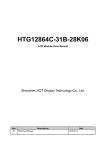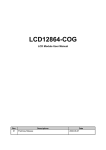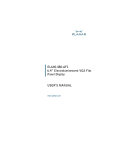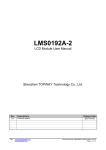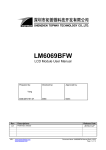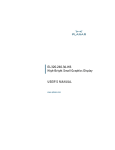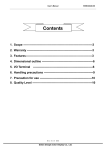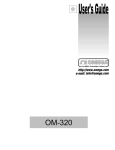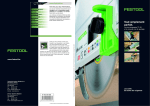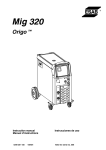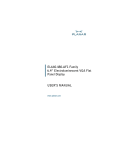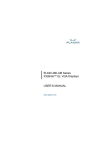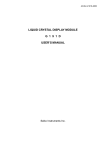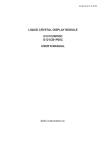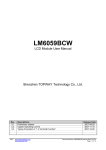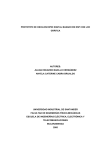Download EL240.128.45 ICEBrite™ EL Small Graphics Display USER`S
Transcript
EL240.128.45 ICEBrite™ EL Small Graphics Display USER’S MANUAL www.planar.com Revision Control Date Description August 2000 Document number OM320-00 June 2004 Document number 020-0345-00A Contents EL240.128.45 Display................................................................................................................................................3 Features ....................................................................................................................................................................3 Installation and Handling........................................................................................................................................3 Mounting EL Displays ..........................................................................................................................................4 Cable Length...........................................................................................................................................................4 Cleaning ...................................................................................................................................................................4 Avoiding Burn-In ...................................................................................................................................................4 Specifications ..............................................................................................................................................................5 Power.........................................................................................................................................................................5 Connector ................................................................................................................................................................7 Interface Information...........................................................................................................................................8 Video Input Signals.......................................................................................................................................... 9 Dimming ................................................................................................................................................................11 Self-Test Mode......................................................................................................................................................11 Power-up Sequence...........................................................................................................................................11 Optical.....................................................................................................................................................................12 Command Description......................................................................................................................................12 Required register settings and configuration items..........................................................................12 Environmental......................................................................................................................................................13 Reliability................................................................................................................................................................13 Safety and EMI Performance ...........................................................................................................................13 Mechanical Characteristics ..............................................................................................................................14 Component Envelope .......................................................................................................................................14 Description of Warranty ........................................................................................................................................16 Ordering Information .............................................................................................................................................16 Support and Service................................................................................................................................................16 Figures Figure 1. Power Curve Diagram .......................................................................................................................6 Figure 2. Data/Power Connector - J1 .............................................................................................................7 Figure 3. 8080 Video Input Timing Diagram ...............................................................................................9 Figure 4. 6800 Video Input Timing Diagram .............................................................................................10 Figure 5. Display Dimensions..........................................................................................................................15 Tables Table 1. DC Input Voltage Requirements. ....................................................................................................5 Table 2. Video Input Requirements. ...............................................................................................................6 Table 3. Connector Pinouts - J1........................................................................................................................7 Table 4. Pin Settings.............................................................................................................................................8 Table 5. 8080 Video Input Timing Description ...........................................................................................9 Table 6. 6800 Video Input Timing Description .........................................................................................10 Table 7. Luminance Control ............................................................................................................................11 Table 8. Optical Characteristics ......................................................................................................................12 Table 9. Environmental Characteristics.......................................................................................................13 Table 10. Mechanical Characteristics ...........................................................................................................14 EL240.128.45 Display The EL240.128.45 thin film electroluminescent (EL) small graphics display utilizes Planar’s proprietary Integral Contrast Enhancement (ICE™) technology to achieve unparalleled image quality without the use of expensive filters. This small graphics display excels in a wide range of ambient lighting environments while effectively eliminating the blooming common to other high-bright displays. The display consists of an EL glass panel and control electronics connected using elastomeric interconnects into a space-saving, rugged package for easy mounting and includes a DC/DC converter. The EL240.128.45 is easily interfaced using a built-in EPSON SED1335F standard LCD controller. Each of the pixels has an aspect ratio of 1:1 (V:H) and is individually addressable to clearly display high information content graphics and text. Features and Benefits • Excellent visual performance: High brightness and contrast Wide viewing angle > 160° No compensation needed • Rapid display response < 1 ms • Space efficient mechanical package • Low EMI emissions • Extremely rugged and durable • Low power (3 W) • Reliable, long operating life with >100,000 MTBF • Built-in EPSON SED1335F standard LCD controller Installation and Handling Do not drop, bend, or flex the display. Do not allow objects to strike the surface of the display. CAUTION: The display uses CMOS and power MOS-FET devices. These components are electrostatic sensitive. Unpack, assemble, and examine this assembly in a static-controlled area only. When shipping, use packing materials designed for protection of electrostatic-sensitive components. CAUTION: To prevent injury in the event of glass breakage, the use of an impact resistant shield or a protective overlay should be used on the viewer side of the display. EL240.128.45 Operations Manual (020-0345-00A) 3 Mounting EL Displays Properly mounted, EL displays can withstand high shock loads as well as severe vibration found in demanding applications. However the glass panel used in an EL display will break if subjected to bending stresses, high impact, or excessive loads. Stresses are often introduced when a display is mounted into a product. Ideally, the mounting tabs of the display should be the only point of contact with the system. Use a spacer or boss for support; failure to do so will bend the display and cause the glass to break. The instrument enclosure or frame should not flex or distort in such a way that during use the bending loads might be transferred to the display. Mounting surfaces should be flat to within ±0.6 mm (±.025"). Use all the mounting holes provided. Failure to do so will impair the shock and vibration resistance of the final installation. The EL240.128.45 is a tab mounted display. Use appropriate length standoffs to assure that screws through the mounting tabs do not introduce bending stresses into the display. Do not deflect the ECB out of its normal plane. The EL240.128.45 mounting tabs were designed for a 3 mm screw. WARNING: These products generate voltages capable of causing personal injury (high voltage up to 230 Vac ). Do not touch the display electronics during operation. Cable Length A maximum cable length of 600 mm (24 in.) is recommended. Longer cables may cause data transfer problems between the data transmitted and the display input connector. Excessive cable lengths can pick up unwanted EMI. Cleaning As with any glass or coated surface, care should be taken to minimize scratching. Clean the display glass with mild, water-based detergents only. Apply the cleaner sparingly to a soft cloth, then wipe the display. Disposable cleaning cloths are recommended to minimize the risk of inadvertently scratching the display with particles embedded in a re-used cloth. Particular care should be taken when cleaning displays with anti-glare and anti-reflective films. Avoiding Burn-In As with other light emitting displays, displaying fixed patterns on the screen can cause burn-in, where luminance variations can be noticed. Use a screen saver or image inversion to avoid causing burn-in on the display. 4 EL240.128.45 Operations Manual (020-0345-00A) Specifications The EL panel is a matrix structure with column and row electrodes arranged in an X-Y formation. Light is emitted when an AC voltage of sufficient amplitude is applied at a row-column intersection. The display operation is based on the symmetric, line-at-a-time data addressing scheme. Power The supply voltages are shown in Table 1. All internal high voltages are generated from the display supply voltage (VH). The logic supply voltage (VL) should be present whenever video input signals are applied. The minimum and maximum specifications in this manual should be met, without exception, to ensure the long-term reliability of the display. Performance characteristics are guaranteed when measured at 25 °C with rated input voltage unless otherwise specified. Planar does not recommend operation of the display outside these specifications. Table 1. DC Input Voltage Requirements. Description Input voltage (nom=12.0V) Input voltage absolute max. Input current (VH =12.0V) Logic voltage (nom=5.0V) Logic voltage absolute max. Logic current Power consumption @120 Hz Power consumption @240 Hz Name Min VH VH max IH VL VL max IL 8 --4.75 -0.5 -- Typ* (W) Max Absolute Max 18.0 19.0 0.95 5.25 6.0 3.1 5.8 90 5.5 10.9 Units Vdc Vdc Adc Vdc Vdc mAdc W W *15% of pixels on per row CAUTION: Absolute maximum ratings are those values beyond which damage to the device may occur. EL240.128.45 Operations Manual (020-0345-00A) 5 Figure 1. Power Curve Diagram Power vs. ON-pixels @ 120 Hz 100 90 80 70 Relative power (%) 60 50 40 30 20 10 0 0% 10% 20% 30% 40% 50% 60% 70% 80% 90% 100% ON-pixels Table 2. Video Input Requirements. Description Symbol Min Max Units Absolute Input Voltage Range VI max -0.3 VL + 0.3 V Low-level input voltage VIL 0 0.2 x VL V HIgh-level input voltage (except SEL1) HIgh-level input voltage SEL1, /RES VIH 0.5 x VL 0.8 x VL VL VL V IL – ±10 (-2000) µA Logic input current* * Signals /WR, /CS, SEL1, /RD, SELFTEST, /RES have pullup resistors (4.7k) 6 EL240.128.45 Operations Manual (020-0345-00A) Connector Video signals and DC power are supplied to the display through a single 24pin, dual-row, 2 mm pitch square pin, right-angle, locking connector: Samtec part number EHT-112-01-S-D-RA, or an equivalent connector matching the pinouts in Table 3. The mating connector is the Samtec TCSD family of cable strips. Consult your Samtec representative (1-800-SAMTEC9) for cable and connector options. (Back of display) (Viewed from top of connector) Key Pin 1 Pin 2 J1 Pin 1 (Bottom of display) Figure 2. Data/Power Connector – J1. Table 3. Connector Pinouts J1. Pin Signal Description Pin Signal Description 1 VH Display voltage 2 VH(+12 V) 3 GND Ground 4 GND Ground 5 VL (+5 V) Logic voltage 6 RES Reset 7 /WR Write 8 /RD Read 9 /CS Chip Select 10 A0 Address 11 SELFTEST 12 GND Ground 13 D0 input/output 14 D1 input/output 15 D2 input/output 16 D3 input/output 17 D4 input/output 18 D5 input/output 19 D6 input/output 20 D7 input/output 21 SEL1 Select Interface 22 READY Display ready 23 GND Ground 24 LUMA Luminance control EL240.128.45 Operations Manual (020-0345-00A) 7 Interface Information This Small Graphics Display (SGD) incorporates an interface that is compatible with the 8-bit microprocessor interfaces found in comparable LCD displays with built-in controllers. The display incorporates a built-in EPSON SED1335F standard LCD controller. Table 4. Pin Settings. Signal D0 to D7 SEL1 /RD or E /WR or R//W /RES READY /CS A0 SELF-TEST VL (+5V) VH (+12V) LUMA 8 Functional Description Pins 13-20: Tristate input/output pins. Connect to an 8- or 16-bit microprocessor bus. Pin 21: Microprocessor interface select. Both 8080-family processors and 6800-family processors are supported. SEL1 should be tied directly to VL or GND to prevent noise. SEL1 Interface A0 /RD /WR /CS 0 8080 family A0 /RD /WR /CS 1 6800 family A0 E R//W /CS Pin 8: With the 8080 interface, this signal acts as the active-LOW read strobe. With the 6800 interface, this signal acts as the active-HIGH enable clock. Data is read from or written to the display when this clock goes HIGH. Pin 7: With the 8080 interface, this signal acts as the active-LOW write strobe. The bus data is latched on the rising edge of this signal. With the 6800 interface, this signal acts as the read/write control signal. Data is read from the display if this signal is HIGH, and written to the display if it is LOW. Pin 6: When low resets SED 1335, must be high or unconnected in normal operation Pin 22: OUTPUT When data for Row 128 is written to display drivers this signal goes high. While the signal is high it is possible to write data to SED 1335 memory so that it does not cause disturbances to display data. This signal goes low at latest 3.5 µs before when loading of Row 1 data begins. Signal READY output is CMOS with 100 ohm series resistor. Pin 9: Chip select. This active-LOW input enables the SED1335F. It is usually connected to the output of an address decoder device that maps the SED1330F/1335F/1336F into the memory space of the controlling microprocessor. Pin 10: A0, in conjunction with the /RD and /WR or R//W and E signals, control the type of access to the display, as shown below. 8080 Family Interface A0 /RD /WR Function 0 0 1 Status flag read 1 0 1 Display data and cursor address read 0 1 0 Display data and parameter write 1 1 0 Command write 6800 Family Interface A0 /RD /WR Function 0 1 1 Status flag read 1 1 1 Display data and cursor address read 0 0 0 Display data and parameter write 1 0 1 Command write Pin 11: This pin should be connected to GND for normal display operation. When high, display operates in SELFTEST mode Pin 5: +5V logic supply voltage Pins 1 and 2: +12V supply for DC-DC converter and display analog circuits Pin 24: Luminance control input EL240.128.45 Operations Manual (020-0345-00A) GND Pins 3, 4, 12, and 23: Signal return for logic and power supplies Video Input Signals Figure 3. 8080 Video Input Timing Diagram. Table 5. 8080 Video Input Timing Description. Signal A0, CS WR, RD D0 to D7 All signals Symbol Parameter Condition min max unit tAH8 Address hold time 10 - ns tAW8 tCYC tCC tDS8 tDH8 tACC8 tOH8 Tr, Tf Address setup time System cycle time Strobe pulsewidth Data setup time Data hold time RD access time Output disable time Input rise and fall times 0 550 120 120 5 10 50 50 30 ns ns ns ns ns ns ns ns CL=100pF EL240.128.45 Operations Manual (020-0345-00A) 9 Figure 4. 6800 Video Input Timing Diagram. Table 6. 6800 Video Input Timing Description. Signal Symbol Parameter A0, /CS, tCYC6 System cycle time R//W tAW6 tAH6 tDS6 tDH6 tOH6 tACC6 tEW Tr, Tf Address setup time Address hold time Data setup time Data hold time Output disable time Access time Enable pulsewidth Input rise and fall times D0 to D7 E All signals 10 EL240.128.45 Operations Manual (020-0345-00A) Condition min 550 max - Unit ns 0 0 100 0 10 120 50 85 ns ns ns ns ns 30 ns CL=100pF Dimming The dimming control circuitry on the display allows the user to adjust the luminance from 5% to 95% of the maximum brightness. To control the display luminance, connect a 50 k (ohm) variable resistor between ground and the dimming pin (LUMA). The full resistance of 50 k (ohm) will result in 95% of the maximum luminance. Reducing the resistance will reduce the luminance, with resistance of 0 k (ohm) yielding roughly 5% of the maximum luminance. Alternatively an external voltage or current-mode D/A converter may be used to dim the display by sinking a maximum of 250 µA for maximum dimming from LUMA to ground. When left open, the luminance will remain at the maximum level. Table 7. Luminance Control. Maximum (No resistor connected): 100% (Default) Maximum (50 k Ω resistor connected): 95 % Minimum (0 Ω resistor connected): 5% maximum Open Circuit voltage 4 V nominal Sink Current 250 µA max, Vin = 0V Luminance values are measured as a percentage of full On Luminance (with the external resistor disconnected.) Self-Test Mode The display incorporates a self-test mode composed of a 1 x 1 checkerboard and full-on pattern displayed at 240 Hz. Upon power up, the 1 x 1 pattern is displayed for several seconds, then the full-on pattern is displayed continuously. The self-test mode is entered by leaving the SELFTEST pin pulled high. For normal operation the SELFTEST pin must be pulled to a logic low. If the SELFTEST pin is pulled high during normal operation, the display will enter the self-test mode with the all-pixels-on pattern. Power-up Sequence No special power-up or video sequencing is required. EL240.128.45 Operations Manual (020-0345-00A) 11 Optical Table 8. Optical Characteristics. Luminance Lon (areal), typ Lon (areal), min Loff (areal), max 65 cd/m² 130 cd/m² 45 cd/m² 90 cd/m² 0.30 cd/m² @ 120 Hz @ 240 Hz @ 120 Hz @ 240 Hz @ 240 Hz Non-uniformity All pixels fully lit 25% Maximum difference between any 2 of 5 points, using the formula: LNU%=[1- (min_lum/max_lum)] x 100% Luminance Variation (Temperature) Maximum ±20% From 25 °C to operating temp. extremes; all pixels on. Luminance Variation (Time) Maximum <20% 10,000 hours at 25°C ambient; all pixels on. Viewing Angle Minimum >160° Contrast Ratio 500 lux 5000 lux 55:1 @ 120 Hz frame rate; 97:1 @ 240 Hz frame rate 7.1:1 @ 120 Hz frame rate; 13:1 @ 240 Hz frame rate Command Description The EL240.128.45 display is driven by the EPSON SED1335F controller. For details on using this controller, refer to the Command Description section of the SED 1335 technical manual titled SED1330F/1335F/1336F LCD Controller ICs Technical Manual. This document is on the EPSON website at www.epson-electronics.de Required register settings and configuration items • The module uses one 32kx8 SRAM for all CG and display memory. • W/S, bit 3 of the P1 byte of the SYSTEM SET instruction, is set to 0 for a single drive panel. • DR, bit 7 of the P1 byte of the SYSTEM SET instruction, is set to 0 to turn off the additional output cycle of the shift clock • The recommended SYSTEM.SET parameter values are (P1 through P8) in hex, for a frame rate of 240 Hz: 32, 07, 07, 1D, 23, 7F, 1E, and 00. • P5 must not be less than 23 to guarantee that minimum line period requirement of the display is achieved (32.5us) • The READY flag is high during extra line times, so P6 should be over 7F if the READY flag is used. After the falling edge of the READY flag there is min. 3.5 µs time to end the display memory write cycle. • Oscillator frequency to EPSON SED1335F is 10 MHz 12 EL240.128.45 Operations Manual (020-0345-00A) Environmental Table 9. Environmental Characteristics. Temperature Operating Operating survival Non-operating Humidity Operating -20 °C to +70 °C -40 °C to +85 °C -50 °C to +105 °C After 12 hours at -50°C, display must be at -40°C for 1 hour prior to power on. Non-operating to 93% RH max @ 40ºC, per IEC 68-2-3 (Non-condensing) to 95% RH max @ 25-55°C, per IEC 68-2-30 (Condensing) Altitude Operating/non-operating 0 to 18,000 m per IEC 68-2-13 Vibration Operating/non-operating Mechanical Shock Operating/non-operating 2 0.02g /Hz, 5-500 Hz, 30 minutes on each axis, per IEC 68-2-36, Random 100 g, 6 ms duration (half sine wave), three shocks per surface (6), tested per IEC 68-2-27, Test Ea Thermal Shock -40°C for 30 min., room temperature for ~3 min., then 85°C for 30 min. Cycle repeated five times. Displays are non-operating during the tests performed per IEC 68-2-14. Test Na. Reliability The display MTBF is demonstrated to be greater than 100,000 hours at maximum frame rate with a 90% confidence level at 25°C. Safety and EMI Performance The display will not inhibit the end product from complying with FCC Part 15 Subpart J, Class B and EN55022 Class B when housed in a suitable enclosure. The display will be a recognized component under UL1950 by Underwriters Laboratories. The display will not inhibit the end product from complying with CSA C22.2 No. 950 and EN60950. EL240.128.45 Operations Manual (020-0345-00A) 13 Mechanical Characteristics Table 10. Environmental Characteristics. Display External Dimensions millimeters (inches) width without locking connector with locking connector height depth 128.0 (5.04) nominal ~140.0 mm w/ mounting ears 77.0 (3.03) nominal 14.8 (0.59) nominal Weight 115g (4.1 oz) nominal Fill Factor 71.3% Display Active Area millimeters (inches) Pixel Size millimeters (inches) Pixel Pitch millimeters (inches) width height diagonal 107.9 (4.25) nominal 57.5 (2.26) nominal 122.3 (4.8) nominal width height 0.26 (0.01) 0.26 (0.01) horizontal vertical 0.45 (0.018) nominal 0.45 (0.018) nominal Component Envelope The component envelope shown in Figure 4 illustrates the distance components extend behind the display. Tall components do not necessarily fill this area. Planar reserves the right to relocate components within the constraints of the component envelope without prior customer notification. For this reason, Planar advises users to design enclosure components to be outside the component envelope. An air gap of at least 5 mm is recommended to dissipate heat from display components. Device designers will need to consider their specific system requirements to determine the necessary spacing. 14 EL240.128.45 Operations Manual (020-0345-00A) Dimensions in are millimeters. Tolerances unless specified: .x ±0.50 ±0.25 .xx Figure 5. Display Dimensions. Note: This is not a controlled version of the mechanical drawing. Prior to beginning your design, please contact Planar Applications Engineering for the current detailed drawing. EL240.128.45 Operations Manual (020-0345-00A) 15 Description of Warranty Seller warrants that the Goods will conform to published specifications and be free from defects in material for 12 months from delivery. To the extent that Goods incorporate third-party-owned software, Seller shall pass on Seller's licensor's warranty to Buyer subject to the terms and conditions of Seller's license. Warranty repairs shall be warranted for the remainder of the original warranty period. Buyer shall report defect claims in writing to Seller immediately upon discovery, and in any event, within the warranty period. Buyer must return Goods to Seller within 30 days of Seller’s receipt of a warranty claim notice and only after receiving Seller’s Return Goods Authorization. Seller shall, at its sole option, repair or replace the Goods. If Goods were repaired, altered or modified by persons other than Seller, this warranty is void. Conditions resulting from normal wear and tear and Buyer's failure to properly store, install, operate, handle or maintain the Goods are not within this warranty. Repair or replacement of Goods is Seller’s sole obligation and Buyer's exclusive remedy for all claims of defects. If that remedy is adjudicated insufficient, Seller shall refund Buyer's paid price for the Goods and have no other liability to Buyer. All warranty repairs must be performed at Seller’s authorized service center using parts approved by Seller. Buyer shall pay costs of sending Goods to Seller on a warranty claim and Seller shall pay costs of returning Goods to Buyer. The turnaround time on repairs will usually be 30 working days or less. Seller accepts no added liability for additional days for repair or replacement. If Seller offers technical support relating to the Goods, such support shall neither modify the warranty nor create an obligation of Seller. Buyer is not relying on Seller’s skill or judgment to select Goods for Buyer’s purposes. Seller’s software, if included with Goods, is sold as is, and this warranty is inapplicable to such software. SELLER DISCLAIMS ALL OTHER WARRANTIES, EXPRESS OR IMPLIED, INCLUDING BUT NOT LIMITED TO, IMPLIED WARRANTIES OF MERCHANTABILITY AND FITNESS FOR A PARTICULAR PURPOSE. Ordering Information Product Part Number Features EL240.128.45 996-0301-01 Standard version Design and specifications are subject to change without notice. Planar Systems continues to provide optional, and in many cases custom, features to address the specific customer requirements. Consult Planar Sales for pricing, lead time and minimum quantity requirements. Support and Service Planar is a U.S. company based in Beaverton, Oregon and Espoo, Finland, with a world-wide sales distribution network. Full application engineering support and service are available to make the integration of Planar displays as simple and quick as possible for our customers. RMA Procedure: For a Returned Material Authorization number, please contact Planar Systems, Inc. with the model number(s) and serial number(s). When returning goods for repair, please include a brief description of the problem, and mark the outside of the shipping container with the RMA number. 16 EL240.128.45 Operations Manual (020-0345-00A) Planar Systems, Inc. Customer Service 24x7 Online Technical Support: http://www.planar.com/support Americas Support 1195 NW Compton Drive Beaverton, OR 97006-1992 Tel: 1-866-PLANAR1 (866) 752-6271 Hours: M-F, 5am - 5pm Pacific Time Europe and Asia-Pacific Support Olarinluoma 9 P.O. Box 46 FIN-02201 Espoo, Finland Tel: +358-9-420-01 Hours: M-F, 7:00am - 4pm CET © 2004 Planar Systems, Inc. 06/04 Planar is a registered trademark of Planar Systems, Inc. ICE, ICEBrite, and ICEPlus are trademarks of Planar Systems, Inc. Other brands and names are the property of their respective owners. Technical information in this document is subject to change without notice. 020-0345-00A




















